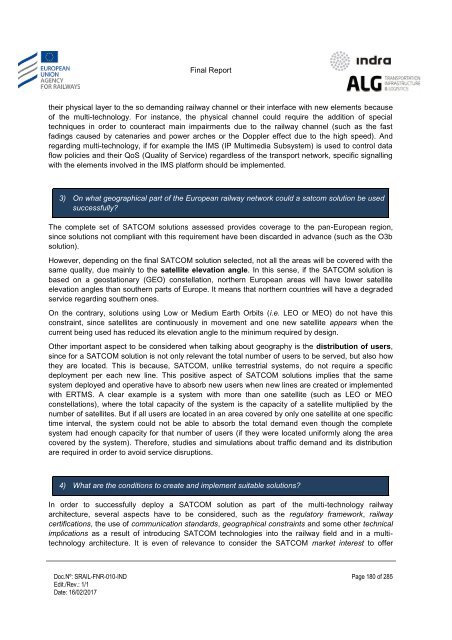Study on feasibility of SATCOM for railway communication
SRAIL-FNR-010-IND%20-%20FinalReport_v1.1_20170216
SRAIL-FNR-010-IND%20-%20FinalReport_v1.1_20170216
Create successful ePaper yourself
Turn your PDF publications into a flip-book with our unique Google optimized e-Paper software.
Final Report<br />
their physical layer to the so demanding <strong>railway</strong> channel or their interface with new elements because<br />
<strong>of</strong> the multi-technology. For instance, the physical channel could require the additi<strong>on</strong> <strong>of</strong> special<br />
techniques in order to counteract main impairments due to the <strong>railway</strong> channel (such as the fast<br />
fadings caused by catenaries and power arches or the Doppler effect due to the high speed). And<br />
regarding multi-technology, if <strong>for</strong> example the IMS (IP Multimedia Subsystem) is used to c<strong>on</strong>trol data<br />
flow policies and their QoS (Quality <strong>of</strong> Service) regardless <strong>of</strong> the transport network, specific signalling<br />
with the elements involved in the IMS plat<strong>for</strong>m should be implemented.<br />
3) On what geographical part <strong>of</strong> the European <strong>railway</strong> network could a satcom soluti<strong>on</strong> be used<br />
successfully?<br />
The complete set <strong>of</strong> <strong>SATCOM</strong> soluti<strong>on</strong>s assessed provides coverage to the pan-European regi<strong>on</strong>,<br />
since soluti<strong>on</strong>s not compliant with this requirement have been discarded in advance (such as the O3b<br />
soluti<strong>on</strong>).<br />
However, depending <strong>on</strong> the final <strong>SATCOM</strong> soluti<strong>on</strong> selected, not all the areas will be covered with the<br />
same quality, due mainly to the satellite elevati<strong>on</strong> angle. In this sense, if the <strong>SATCOM</strong> soluti<strong>on</strong> is<br />
based <strong>on</strong> a geostati<strong>on</strong>ary (GEO) c<strong>on</strong>stellati<strong>on</strong>, northern European areas will have lower satellite<br />
elevati<strong>on</strong> angles than southern parts <strong>of</strong> Europe. It means that northern countries will have a degraded<br />
service regarding southern <strong>on</strong>es.<br />
On the c<strong>on</strong>trary, soluti<strong>on</strong>s using Low or Medium Earth Orbits (i.e. LEO or MEO) do not have this<br />
c<strong>on</strong>straint, since satellites are c<strong>on</strong>tinuously in movement and <strong>on</strong>e new satellite appears when the<br />
current being used has reduced its elevati<strong>on</strong> angle to the minimum required by design.<br />
Other important aspect to be c<strong>on</strong>sidered when talking about geography is the distributi<strong>on</strong> <strong>of</strong> users,<br />
since <strong>for</strong> a <strong>SATCOM</strong> soluti<strong>on</strong> is not <strong>on</strong>ly relevant the total number <strong>of</strong> users to be served, but also how<br />
they are located. This is because, <strong>SATCOM</strong>, unlike terrestrial systems, do not require a specific<br />
deployment per each new line. This positive aspect <strong>of</strong> <strong>SATCOM</strong> soluti<strong>on</strong>s implies that the same<br />
system deployed and operative have to absorb new users when new lines are created or implemented<br />
with ERTMS. A clear example is a system with more than <strong>on</strong>e satellite (such as LEO or MEO<br />
c<strong>on</strong>stellati<strong>on</strong>s), where the total capacity <strong>of</strong> the system is the capacity <strong>of</strong> a satellite multiplied by the<br />
number <strong>of</strong> satellites. But if all users are located in an area covered by <strong>on</strong>ly <strong>on</strong>e satellite at <strong>on</strong>e specific<br />
time interval, the system could not be able to absorb the total demand even though the complete<br />
system had enough capacity <strong>for</strong> that number <strong>of</strong> users (if they were located uni<strong>for</strong>mly al<strong>on</strong>g the area<br />
covered by the system). There<strong>for</strong>e, studies and simulati<strong>on</strong>s about traffic demand and its distributi<strong>on</strong><br />
are required in order to avoid service disrupti<strong>on</strong>s.<br />
4) What are the c<strong>on</strong>diti<strong>on</strong>s to create and implement suitable soluti<strong>on</strong>s?<br />
In order to successfully deploy a <strong>SATCOM</strong> soluti<strong>on</strong> as part <strong>of</strong> the multi-technology <strong>railway</strong><br />
architecture, several aspects have to be c<strong>on</strong>sidered, such as the regulatory framework, <strong>railway</strong><br />
certificati<strong>on</strong>s, the use <strong>of</strong> communicati<strong>on</strong> standards, geographical c<strong>on</strong>straints and some other technical<br />
implicati<strong>on</strong>s as a result <strong>of</strong> introducing <strong>SATCOM</strong> technologies into the <strong>railway</strong> field and in a multitechnology<br />
architecture. It is even <strong>of</strong> relevance to c<strong>on</strong>sider the <strong>SATCOM</strong> market interest to <strong>of</strong>fer<br />
Doc.Nº: SRAIL-FNR-010-IND<br />
Edit./Rev.: 1/1<br />
Date: 16/02/2017<br />
Page 180 <strong>of</strong> 285


